Pierces Pass to Blue Gum Forest walking track
Blackheath area in Blue Mountains National Park
Learn more
Learn more about why this park is special
Pierces Pass to Blue Gum Forest walking track is in Blackheath area. Here are just some of the reasons why this park is special:
Inspiration and information
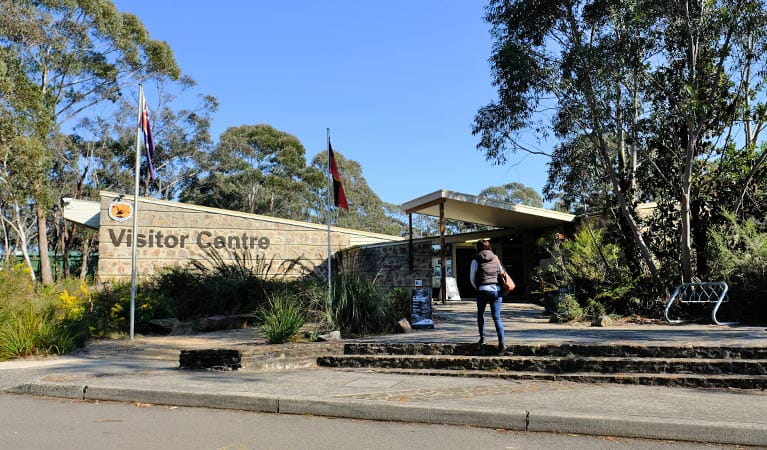
Blackheath is home to the Blue Mountains Heritage Centre. This is your one-stop-shop for maps and information on national parks in the Greater Blue Mountains Area World Heritage Property. Take advantage of free wi-fi, book a tour, and read the displays. Try the visitor centre's unique virtual reality tour through Claustral Canyon (costs apply). Or, head out the back doors to the picnic tables and start of wheelchair-accessible Fairfax Heritage walk. Kids can learn more on a school holiday activity or excursion. You can even hire the theatrette for your next event.
- Blue Mountains Heritage Centre Visit Blue Mountains Heritage Centre to get expert advice on walking tracks, Aboriginal heritage, plants and animals and activities.
- Evans lookout Head to Evans lookout if you're seeking an accessible spot with iconic Blue Mountains views, especially at at sunrise or sunset. It's also the starting point for several walks.
- Fairfax Heritage walking track Family and wheelchair friendly, Fairfax Heritage walking track offers summer wildflowers, and scenic lookouts with waterfall views over Grose Valley, in Blue Mountains National Park.
A haven for plants and animals
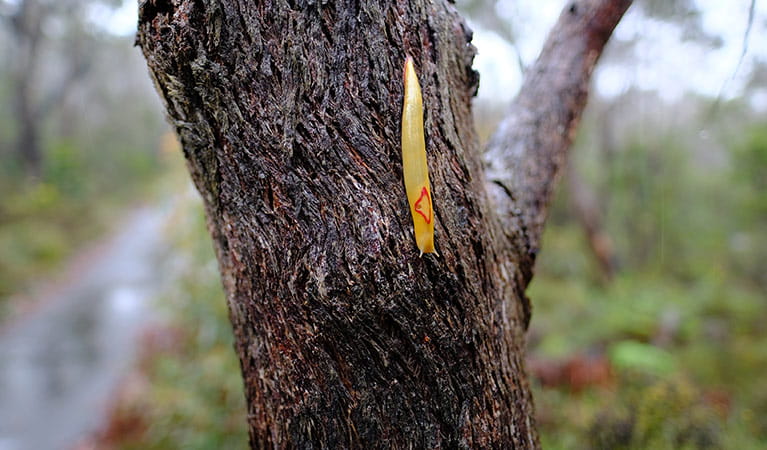
The Blackheath area is a haven for many rare and threatened species. The Blue Mountains cliff mallee tree is found only in the upper mountains on exposed cliff edges. In October, you may see a rare giant dragonfly, which has a wing span up to 12.5cm and body as thick as your little finger. Stroll along Fairfax Heritage track for a chance to see Australia’s largest native land slug, the red triangle slug—they only come out in rain. Nearby Barrow lookout, along Cliff Top walking track, has great views of a remarkable hanging swamp. The swamp feeds a rare plant known as Fletcher’s drumsticks which only grows in the Blackheath area.
- Blue Gum Forest Blue Gum Forest is a fine, historic example of closed forest, situated in Grose Valley in Blue Mountains National Park. Get to it by walking track from Perrys lookdown or Pierces Pass.
- Bush alive: The buzz on bees Buzz along to the Blue Mountains Heritage Centre in Blackheath these school holidays and learn about our wonderful native bees.
- Cliff Top walking track Cliff Top walking track between Govetts Leap and Evans lookout offers some of the most breath taking scenic views in all of the Blue Mountains. You'll be spoiled with birdwatching, wildflowers, and pl...
- Fairfax Heritage walking track Family and wheelchair friendly, Fairfax Heritage walking track offers summer wildflowers, and scenic lookouts with waterfall views over Grose Valley, in Blue Mountains National Park.
- Leaping lizards: Blackheath Do you love lizards? Join in the reptile fun at Blackheath in Blue Mountains National Park. You’ll get to explore their habitat and find out how you can help to protect our reptiles.
In the footsteps of early tourists
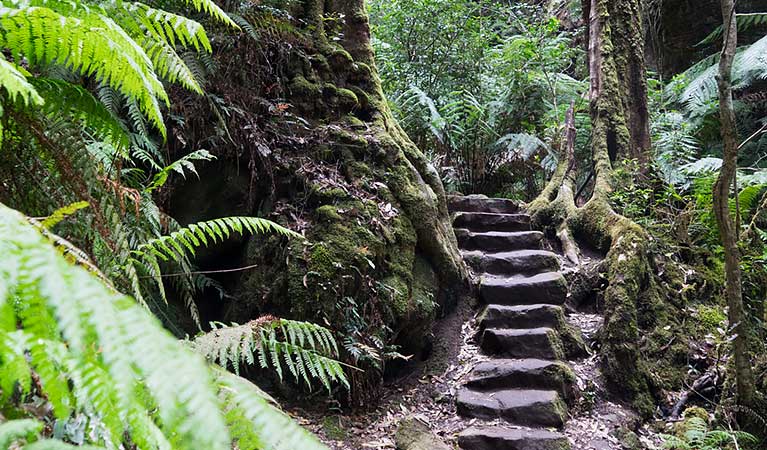
The fresh Blue Mountains air has been promoted as a health tonic from the early 1800s. Today, you can follow in the footsteps of early European tourists along Blackheath’s many historic tracks. Grand Canyon track has drawn visitors to its stone steps since 1907. The spectacular Govetts Leap descent took 2 men 7 months to cut and blast the track, following natural faults and ledges in the cliff. Many of the original hand tool marks are visible on the stone stairway. Along other tracks you may see heritage signs, old timber stairs, metal handrails, bridges and ladders.
- Blue Gum Forest Blue Gum Forest is a fine, historic example of closed forest, situated in Grose Valley in Blue Mountains National Park. Get to it by walking track from Perrys lookdown or Pierces Pass.
- Govetts Leap descent A challenging walk from Govetts Leap lookout, Govetts Leap descent will delight hikers who enjoy a harder walking track, with scenic waterfall views across Grose Valley in Blue Mountains National Park...
- Grand Canyon track Set out from Grand Canyon carpark near Blackheath and be met with a series of waterfalls, creeks and spectacular views along the challenging Grand Canyon track in the Blue Mountains.
Ancient landscapes
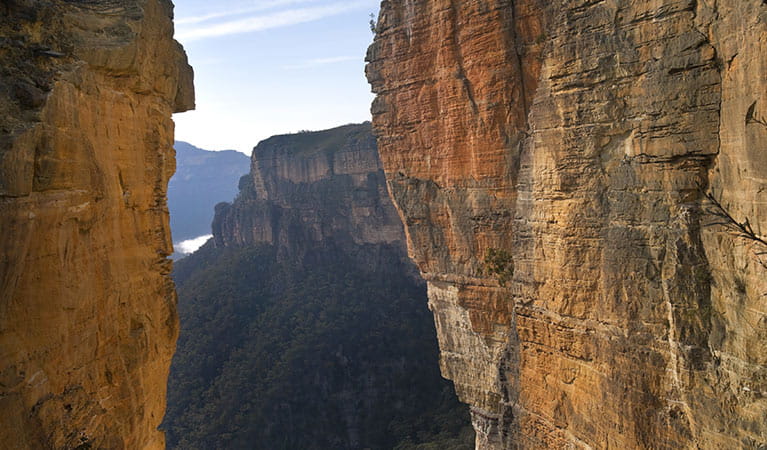
You’ll find some of the most photographed landscapes in Blue Mountains National Park in the Blackheath area. The cluster of lookouts around the rim of the Grose Valley provide ever-changing views. Marvel at sweeping sandstone escarpments, sheer cliff walls, deep canyons, tall waterfalls and hazy blue forests. It’s taken 15 million years to carve out the Grose Valley through a combination of volcanic uplift and erosion. From Perrys Lookdown relish the views across to Mount Banks, with its 500m cliff walls. Walk or ride to the rocky outcrops around Mount Hay, Hanging Rock, or Wind Eroded Rock.
- Blue Mountains 2-day rope and ride adventures Join the Blue Mountains Adventure Company for 2 action-packed days in stunning wilderness surrounds. Explore cliffs and canyons by rope on your first day, and cycle scenic wilderness trails the next.
- Blue Mountains guided climbs and instruction Whether you’re a novice or seasoned climber, Blue Mountains Climbing School has tailored experiences to suit you. It’s a great way to enjoy this thrilling adventure sport in beautiful World Heritage s...
- Burramoko Ridge (Hanging Rock) trail Enjoy mountain biking or a day walk with fantastic gorge views along Burramoko Ridge (Hanging Rock) trails, in the Grose Wilderness of Blue Mountains National Park, near Blackheath.
- Butterbox Canyon For fit and experienced climbers only, Butterbox Canyon near Leura is a challenging technical route. Come ready for lots of abseiling, unavoidable swims, and an exposed rock climb to make your exit.
- Govetts Leap lookout Take in the iconic Blue Mountains views from accessible Govetts Leap lookout, including sandstone escarpments, sheer cliff walls, the deep canyons of the Grose Valley, and tall waterfalls.
World-class wilderness
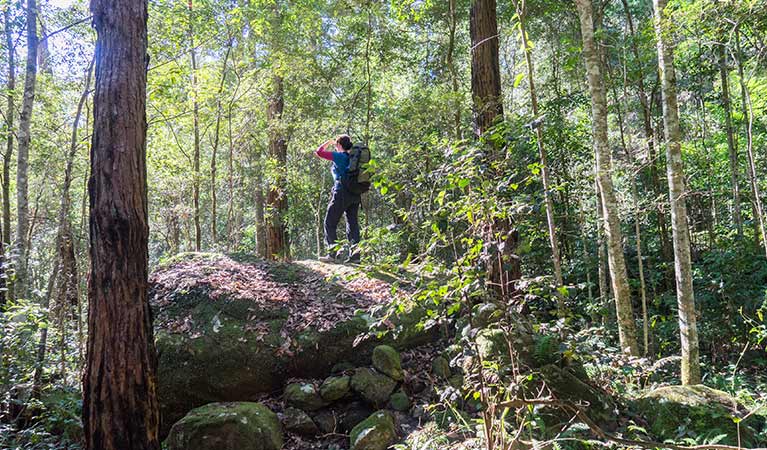
The Grose Wilderness is the only declared wilderness area in Blue Mountains National Park. At the heart of the Grose Wilderness is the magnificent Blue Gum Forest. This closed forest of tall blue gum trees is one of the most secluded areas in the Blue Mountains. It also played an important role in the beginnings of the park and conservation movement in NSW. In 1932, the forest was saved from the axe when a group of bushwalkers pooled their money to buy out the lease. Almost 100 years later, intrepid hikers can hike into this natural wonder via Perrys Lookdown or Pierces Pass.
- Blue Gum Forest Blue Gum Forest is a fine, historic example of closed forest, situated in Grose Valley in Blue Mountains National Park. Get to it by walking track from Perrys lookdown or Pierces Pass.
- Blue Mountains deluxe guided day tours Journey into the heart of the Blue Mountains with the knowledgeable guides of AEA Luxury Tours. You’ll experience waterfalls, wildlife and other scenic wonders in stunning World Heritage surrounds, an...
- Great Divide iconic landscapes tours Explore the plateaus and mountains of the Great Dividing Range on this epic adventure with Nature Bound Australia. Travelling in a small group, you’ll experience some of Australia’s most spectacular s...
- Junior ranger: Navigation adventure at Blackheath Become a junior ranger this school holidays, on this fun orienteering tour at Blackheath. You'll learn some useful navigation skills along the way.
- Mount Hay summit walking track Short but steep Mount Hay summit walking track rewards experienced bushwalkers with dramatic Grose Valley views, and spring wildflowers in Blue Mountains National Park, near Leura.
Greater Blue Mountains Area World Heritage Property
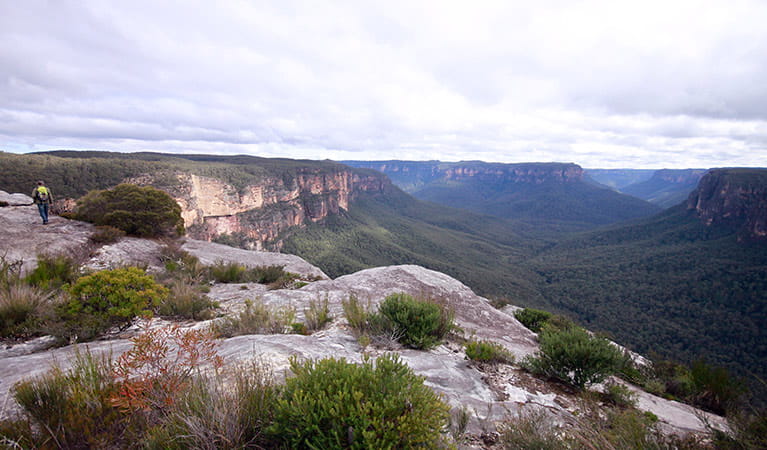
Blue Mountains National Park is 1 of 8 national parks and reserves that make up the Greater Blue Mountains Area World Heritage Property. In 2000, UNESCO recognised the area's outstanding geology, biodiversity, and Aboriginal significance. The area lies within the Country of the Dharug, Gundungurra, Wiradjuri, Darkinjung, Wanaruah and Dharawal People. With more than 1 million hectares of rugged plateaux, sheer cliffs and deep gorges, it protects unique ecosystems teeming with rare plants and animals. Over 99 species of eucalypt trees have evolved here over millions of years, making it the most diverse eucalypt forest in the world. Greater Blue Mountains driving route is a great way to see this ancient wilderness right on Sydney's doorstep. You can also learn more at the Blue Mountains Heritage Centre in Blackheath.
- Blue Gum Forest Blue Gum Forest is a fine, historic example of closed forest, situated in Grose Valley in Blue Mountains National Park. Get to it by walking track from Perrys lookdown or Pierces Pass.
- Blue Mountains corporate adventure experiences Choose MyAdventure Group for an unforgettable team-building experience in the World Heritage surrounds of the Blue Mountains. Each event is custom-designed to challenge your team and meet your goals.
- Blue Mountains deluxe guided day tours Journey into the heart of the Blue Mountains with the knowledgeable guides of AEA Luxury Tours. You’ll experience waterfalls, wildlife and other scenic wonders in stunning World Heritage surrounds, an...
- Grand Canyon Grand Canyon is a short, technical canyon only suitable for fit and experienced canyoners. You’ll need to swim, scramble and do a 20m over-hanging abseil.
- Great Divide iconic landscapes tours Explore the plateaus and mountains of the Great Dividing Range on this epic adventure with Nature Bound Australia. Travelling in a small group, you’ll experience some of Australia’s most spectacular s...
Plants and animals protected in this park
Animals
-
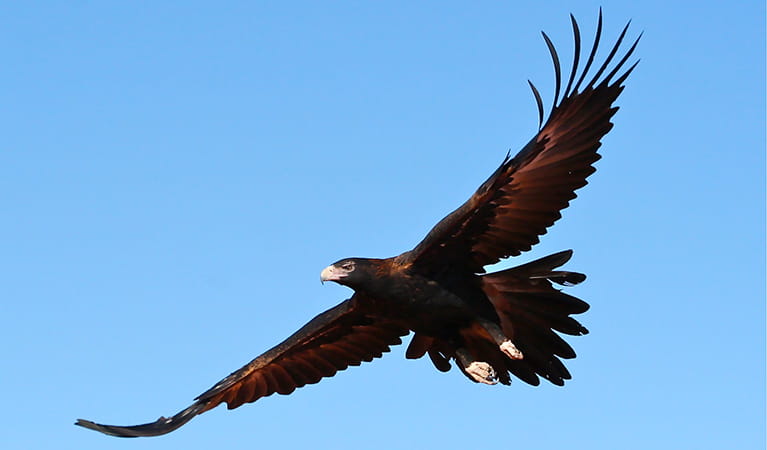
Wedge-tailed eagle (Aquila audax)
With a wingspan of up to 2.5m, the wedge-tailed eagle is Australia’s largest bird of prey. These Australian animals are found in woodlands across NSW, and have the ability to soar to heights of over 2km. If you’re bird watching, look out for the distinctive diamond-shaped tail of the eagle.
-
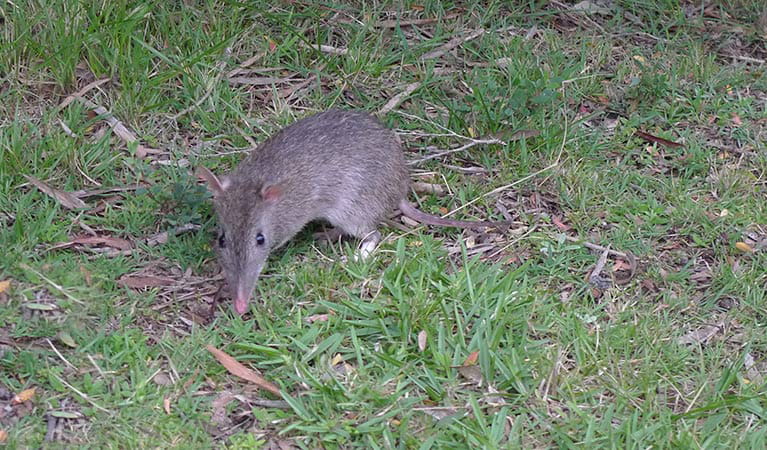
Long-nosed bandicoot (Perameles nasuta)
A nocturnal marsupial and one of the smaller Australian native animals, the long-nosed bandicoot is found across eastern Australia. Populations in the Sydney region have dwindled since European settlement, leaving only endangered colonies in inner western Sydney and at North Head, near Manly. The long-nosed bandicoot has grey-brown fur and a pointed snout which it uses to forage for worms and insects.
-
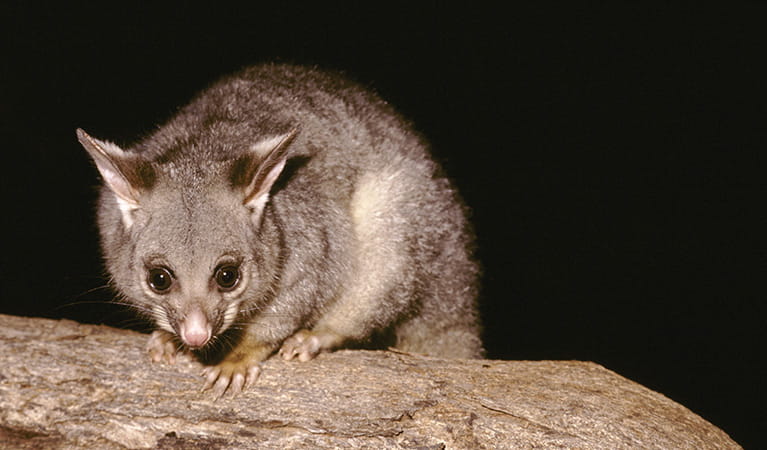
Common brushtail possum (Trichosurus vulpecula)
One of the most widespread of Australian tree-dwelling marsupials, the common brushtail possum is found across most of NSW in woodlands, rainforests and urban areas. With strong claws, a prehensile tail and opposable digits, these native Australian animals are well-adapted for life amongst the trees.
-
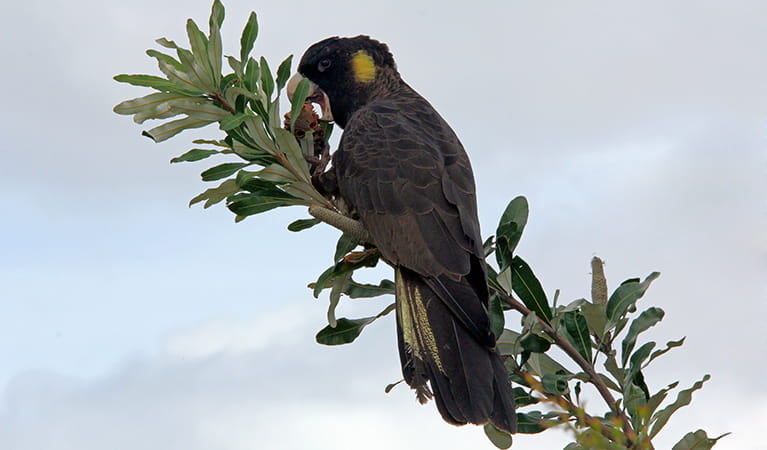
Yellow-tailed black cockatoo (Calyptorhynchus funereus)
The yellow-tailed black cockatoo is one of the largest species of parrot. With dusty-black plumage, they have a yellow tail and cheek patch. They’re easily spotted while bird watching, as they feed on seeds in native forests and pine plantations.
-

Swamp wallaby (Wallabia bicolor)
The swamp wallaby, also known as the black wallaby or black pademelon, lives in the dense understorey of rainforests, woodlands and dry sclerophyll forest along eastern Australia. This unique Australian macropod has a dark black-grey coat with a distinctive light-coloured cheek stripe.
-

Common ringtail possum (Pseudocheirus peregrinus)
Commonly found in forests, woodlands and leafy gardens across eastern NSW, the Australian ringtail possum is a tree-dwelling marsupial. With a powerful tail perfectly adapted to grasp objects, it forages in trees for eucalypt leaves, flowers and fruit.
-
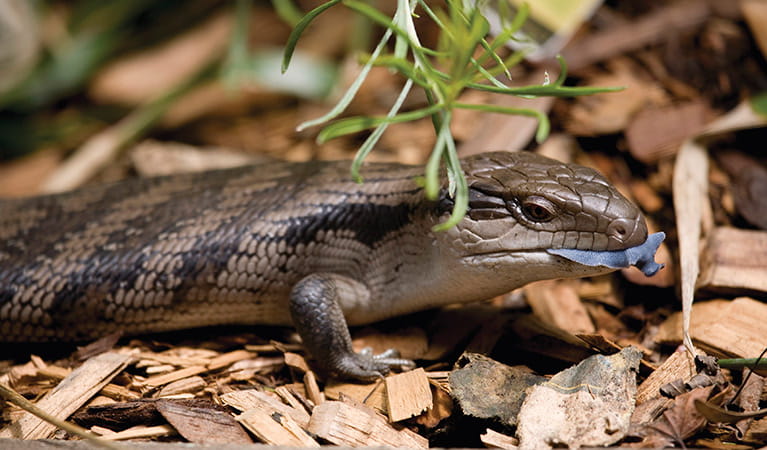
Eastern blue-tongue lizard (Tiliqua scinciodes)
The eastern blue-tongue lizard, one of the largest skinks in Australia, is found throughout most of NSW. When threatened, the eastern blue-tongue lizard displays its blue tongue in a wide-mouthed intimidating show. Not an agile animal, they feed on slow-moving beetles and snails.
-
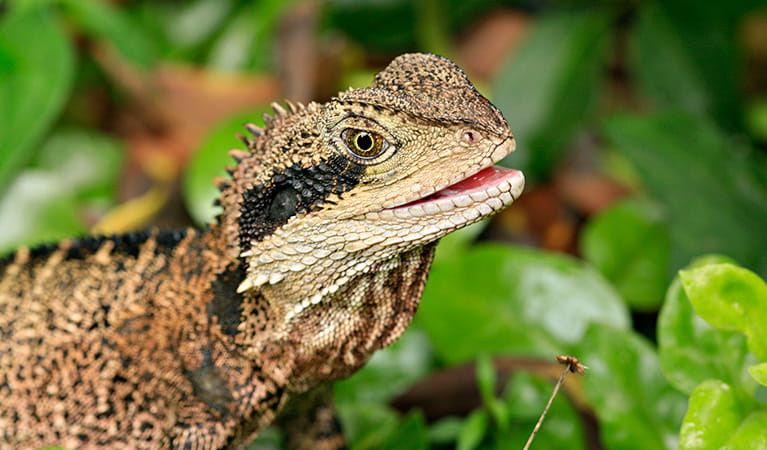
Eastern water dragon (Intellagama lesueurii lesueurii)
The eastern water dragon is a subaquatic lizard found in healthy waterways along eastern NSW, from Nowra to halfway up the Cape York Pensinsula. It’s believed to be one of the oldest of Australian reptiles, remaining virtually unchanged for over 20 million years.
-
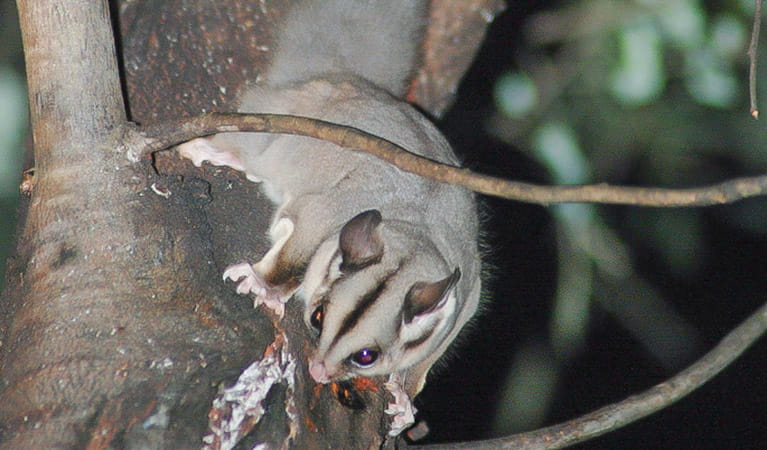
Sugar glider (Petaurus breviceps)
The sugar glider is a tree-dwelling Australian native marsupial, found in tall eucalypt forests and woodlands along eastern NSW. The nocturnal sugar glider feeds on insects and birds, and satisfies its sweet tooth with nectar and pollens.
-

Superb lyrebird (Menura novaehollandiae)
With a complex mimicking call and an elaborate courtship dance to match, the superb lyrebird is one of the most spectacular Australian animals. A bird watching must-see, the superb lyrebird can be found in rainforests and wet woodlands across eastern NSW and Victoria.
Plants
-
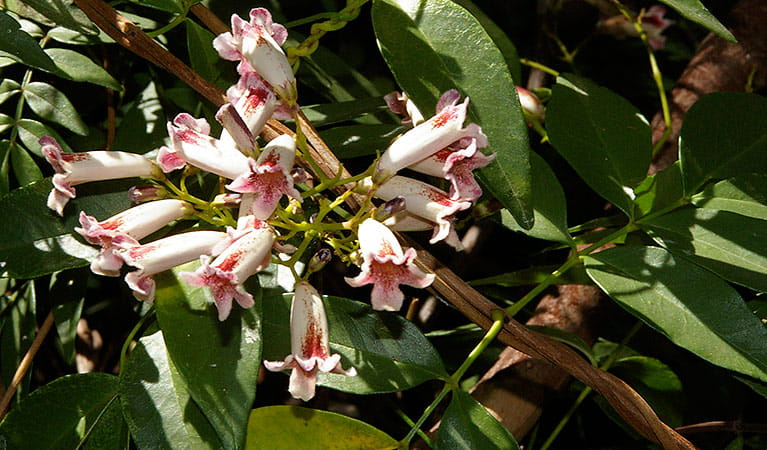
Wonga wonga vine (Pandorea pandorana)
The wonga wonga vine is a widespread vigorous climber usually found along eastern Australia. A variation of the plant occurs in the central desert, where it resembles a sprawling shrub. One of the more common Australian native plants, the wonga wonga vine produces bell-shaped white or yellow flowers in the spring, followed by a large oblong-shaped seed pod.
-
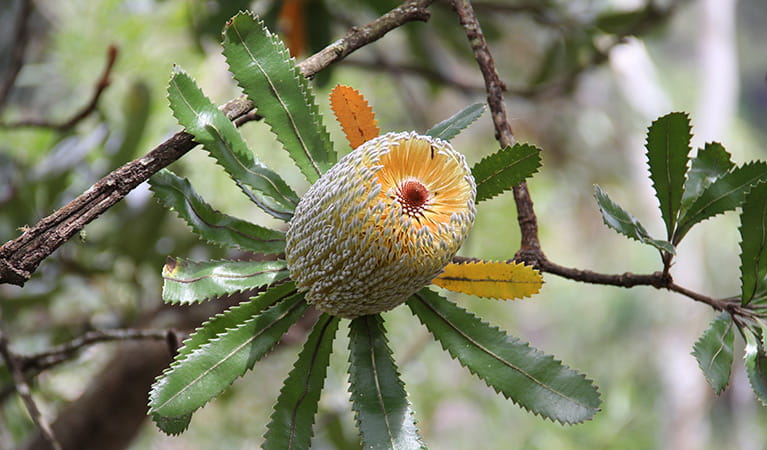
Old man banksia (Banksia serrata)
Hardy Australian native plants, old man banksias can be found along the coast, and in the dry sclerophyll forests and sandstone mountain ranges of NSW. With roughened bark and gnarled limbs, they produce a distinctive cylindrical yellow-green banksia flower which blossoms from summer to early autumn.
-
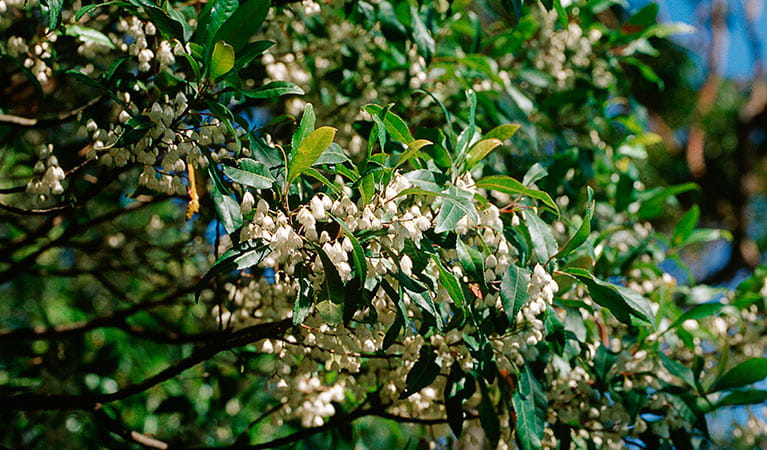
Blueberry ash (Elaeocarpus reticulatus)
The blueberry ash is a rainforest shrub which produces blue olive-shaped berries and spectacular bell-shaped flowers, which often appear on the plant together. It is a tall slender shrub or small tree found in rainforest, tall eucalypt forest and coastal bushland in eastern NSW, south-east Queensland and Victoria.
-
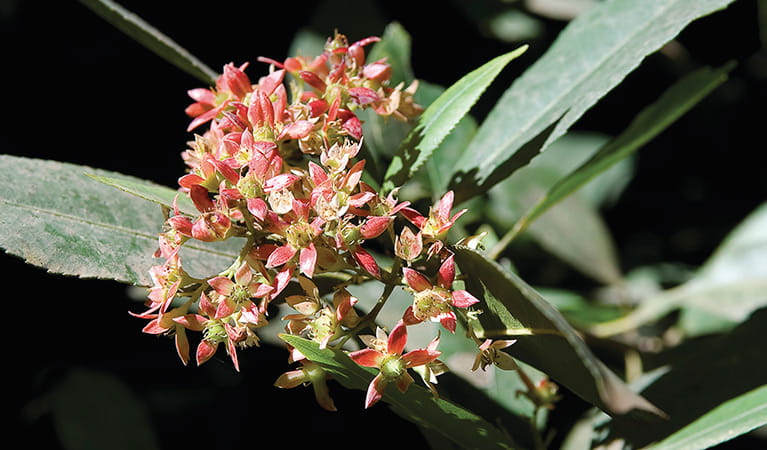
Coachwood (Ceratopetalum apetalum)
Coachwood trees are Australian native plants that grow in warm temperate rainforests along coastal NSW. Also known as scented satinwood, the mottled grey bark of the coachwood has horizontal markings and a delicate fragrance.
-

Coachwood (Ceratopetalum apetalum)
Coachwood trees are Australian native plants that grow in warm temperate rainforests along coastal NSW. Also known as scented satinwood, the mottled grey bark of the coachwood has horizontal markings and a delicate fragrance.
-
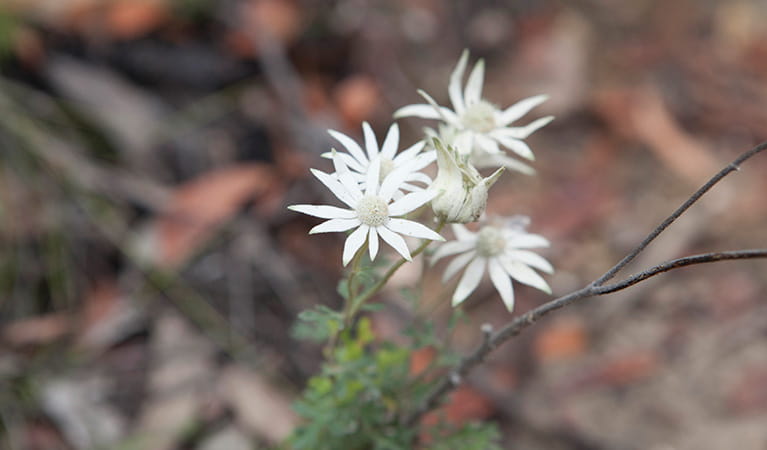
Flannel flower (Actinotus helianthi)
The delicate flannel flower is so named because of the soft woolly feel of the plant. Growing in the NSW south coast region, extending to Narrabri in the Central West and up to south-east Queensland, its white or pink flowers bloom all year long, with an extra burst of colour in the spring.
-

Grass tree (Xanthorrea spp.)
An iconic part of the Australian landscape, the grass tree is widespread across eastern NSW. These Australian native plants have a thick fire-blackened trunk and long spiked leaves. They are found in heath and open forests across eastern NSW. The grass tree grows 1-5m in height and produces striking white-flowered spikes which grow up to 1m long.
-
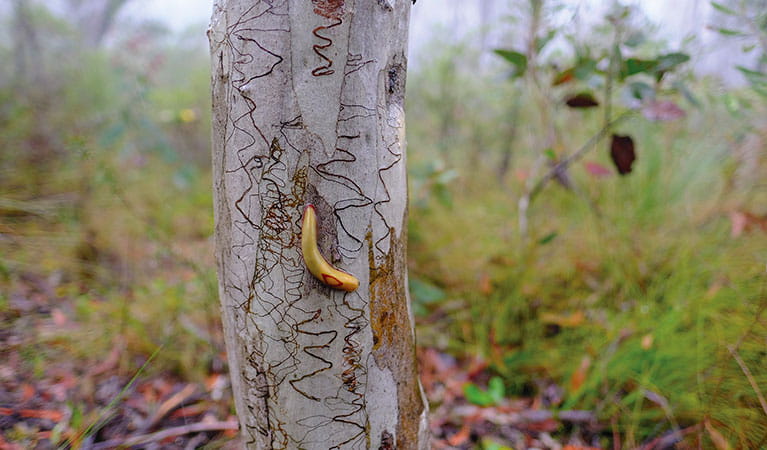
Scribbly gum (Eucalyptus haemastoma)
Easily identifiable Australian native plants, scribbly gum trees are found throughout NSW coastal plains and hills in the Sydney region. The most distinctive features of this eucalypt are the ‘scribbles’ made by moth larva as it tunnels between the layers of bark.
-
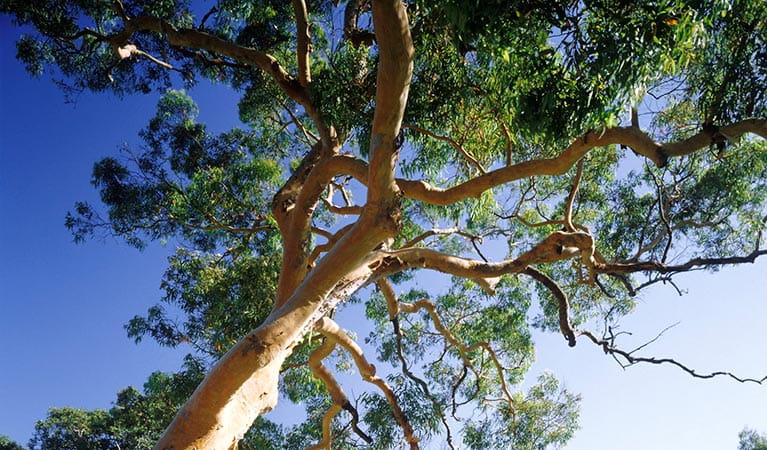
Smooth-barked apple (Angophora costata)
Smooth-barked apple gums, also known as Sydney red gum or rusty gum trees, are Australian native plants found along the NSW coast, and in the Sydney basin and parts of Queensland. Growing to heights of 15-30m, the russet-coloured angophoras shed their bark in spring to reveal spectacular new salmon-coloured bark.
-
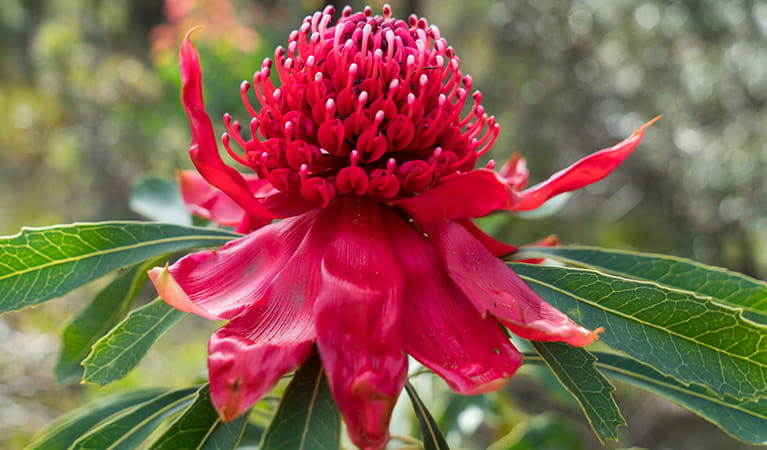
Waratah (Telopea speciosissima)
The beautiful waratah is not only the NSW floral emblem, it's also one of the best-known Australian native plants. This iconic Australian bush flower can be found on sandstone ridges around Sydney, in nearby mountain ranges and on the NSW South Coast. The waratah has a vibrant crimson flowerhead, measuring up to 15cm across, and blossoms in spring.
Look out for...
Blueberry ash
Elaeocarpus reticulatus
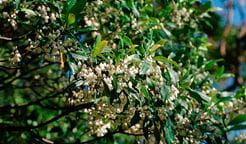
The blueberry ash is a rainforest shrub which produces blue olive-shaped berries and spectacular bell-shaped flowers, which often appear on the plant together. It is a tall slender shrub or small tree found in rainforest, tall eucalypt forest and coastal bushland in eastern NSW, south-east Queensland and Victoria.
Environments in this area
School excursions (2)
- Grand Canyon: Environmental change and management, Stage 5 (Years 9-10), Geography
- Living with fire, Stage 3 (Years 5-6), Geography